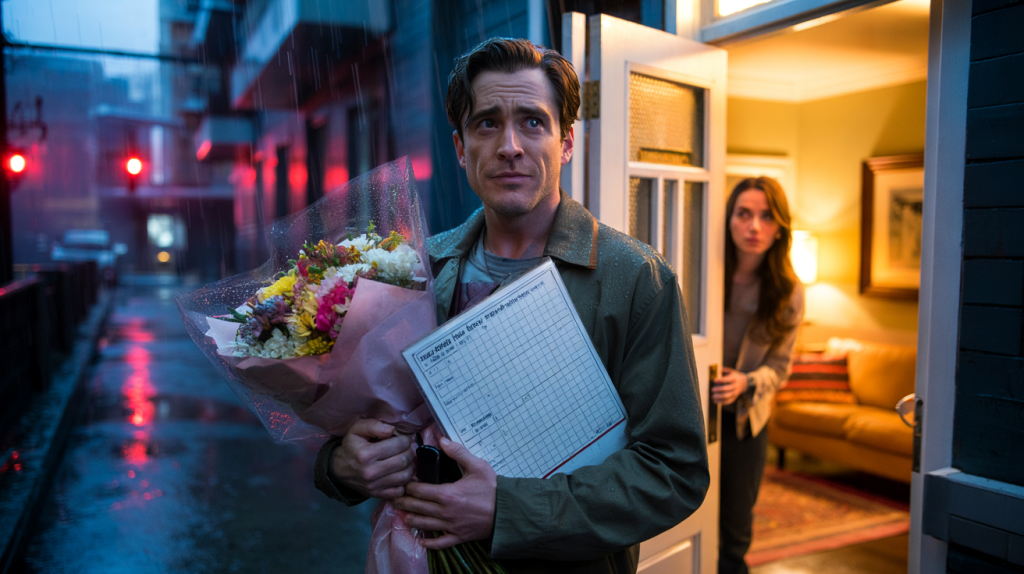One scene and the stomach knots up. The awkward boyfriend on screen fumbles a speech, misreads the room, or crosses a line that is framed as romantic. Viewers wince, then keep watching. These characters power some of the most quoted moments in pop culture because discomfort, done right, is sticky storytelling.
The pattern is familiar. From Ross Geller trailing jealousy in “Friends” to Ted Mosby turning grand gestures into habit in “How I Met Your Mother”, pop romances lean on lovable men who create secondhand embarrassment. The idea is not new, and the numbers show how strongly it travels across time and formats, from 1990s network hits to streaming rewatches and holiday film staples.
Awkward boyfriends on screen: the hook that keeps audiences invested
There is a clear narrative reason. Awkward partners amplify stakes and make the “will they or won’t they” loop feel personal. Small missteps escalate into cliffhangers. A jealous remark becomes a season arc. Viewers tune in for laughs, stay for resolution.
The device works because it mirrors real miscommunication. People recognize overthinking, late night texting, trying too hard. Comedy softens it. Romance reframes it as effort. The mix lowers defenses and invites empathy, even when behavior looks off.
Studios know the pull. Framing imperfection as charm has long been a safe bet in sitcoms and romcoms, while drama uses the same beats to foreshadow control or obsession. Tone decides whether discomfort reads as cute or as a red flag in plain sight.
By the numbers: Ross, Ted, and the cue cards that never die
Scale first. “Friends” ran from 1994 to 2004 and soared during event TV. Its episode “The One After the Super Bowl” drew 52.9 million viewers on 28 January 1996 according to Nielsen. Ross Geller’s anxious boyfriend energy was not niche. It lived at primetime’s center.
Jump to 2014. The “How I Met Your Mother” finale on 31 March 2014 reached 12.9 million viewers per Nielsen reported by CBS. Ted Mosby had spent nine seasons turning impatience into public declarations. Audience engagement held because the character’s awkward persistence defined the show’s rhythm.
Film echoes the pattern. “Love Actually” released in 2003 and grossed about 246.8 million dollars worldwide according to Box Office Mojo. The cue card confession by Andrew Lincoln’s character Mark still resurfaces every December as a cultural debate about boundary crossing dressed as romance.
When awkwardness tilts darker, the box office still follows. “Twilight” in 2008 brought a possessive love story into the mainstream and grossed around 408.4 million dollars globally per Box Office Mojo. The appeal did not rest on perfect behavior. It rested on intensity packaged as destiny.
Common mistakes we copy from screen romances and what to watch for
Scripts compress time. Real life does not. That gap creates mistakes people sometimes copy without noticing. The show makes a grand gesture look normal. The timeline hides the slow talk a healthy couple would actually need.
Another trap is excusing discomfort because the character is framed as “the one”. When a story tells viewers someone is endgame, awkward behavior can get reframed as endearing growth when it might be a pattern that needs addressing.
Numbers add context. Large audiences did not just watch the sweetest moments. They watched the messy ones too. With that in mind, here is a compact viewing checklist that respects the fun without importing the pitfalls.
- Spot the pattern : is the awkward move a one off or recurring
- Separate tone from action : if music changed, would it feel okay
- Check consent signals : clear words beat surprises every time
- Look for accountability : does the character name the mistake
- Time reality : would this make sense outside a 22 minute arc
From cringe to clarity: how to enjoy the trope without normalizing it
Awkward boyfriends trigger empathy because they show effort. That empathy works best when paired with context. Stories compress, glamorize and loop through extremes to earn a finale. Real relationships move slower and handle discomfort with conversation rather than spectacle.
One practical approach is to treat the cringe as a cue. Notice what the scene is trying to do. Is it signaling growth, testing a boundary, or just milking a laugh. The answer shifts how a viewer reads the behavior. It also keeps the pleasure of the genre intact.
Studios will keep using this trope. The track record is proven across decades, from 1996 Nielsen highs to 2003 and 2008 box office tallies sourced from Box Office Mojo. The viewing sweet spot sits in the middle. Enjoy the charm. Name the missteps. And let the next episode deliver the payoff people came for. That balance tends to stick, and it is definitly what keeps audiences pressing play again.
